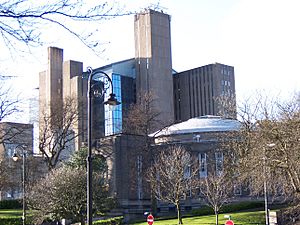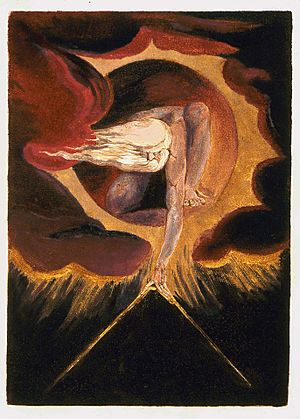Glasgow University Library facts for kids
Quick facts for kids Glasgow University Library |
|
|---|---|
 |
|
| The Main Library Building with the McMillan Reading Room in the foreground. | |
| Country | Scotland |
| Type | Academic library |
| Established | 1475 |
| Location | University of Glasgow |
| Coordinates | 55°52′24″N 4°17′20″W / 55.8733°N 4.2890°W |
| Branches | 8 |
| Collection | |
| Items collected | Books, manuscripts, journals and electronic resources |
| Size | 2.5 million physical volumes across all campus libraries, (4.3 million including e-books). |
| Legal deposit | Formerly (1709-1836) |
| Access and use | |
| Access requirements | Staff, students and alumni of the University of Glasgow |
| Other information | |
| Director | Susan Ashworth (librarian) |
| Staff | 334 |
The University of Glasgow Library in Scotland is one of the oldest and largest university libraries in Europe. A university library is a special library for students and teachers at a university. It helps them with their studies and research.
Today, the main library building has over 1.3 million printed books and many journals. The entire university library system, including smaller branch libraries, holds about 2.5 million books and journals. It also offers access to over 1.8 million e-books and more than 50,000 e-journals. The university also keeps many old documents and records in a separate building. This includes the Scottish Business Archive, which has 6.2 kilometers of old papers!
The current library building is 12 storeys tall. It opened in 1968 and is a famous landmark in Glasgow's West End. You can see its unique shape from far away. In 2014, over 1.7 million people visited the library.
History of the Library
The first time the library was officially mentioned was in November 1475. This was when Bishop John Laing, who was the University's Chancellor, gave his first books to the library.
After a big change called the Protestant Reformation, the University of Glasgow and its library became strong again. This happened when Andrew Melville was in charge from 1574 to 1580. The library grew a lot during the 1700s. This was mainly because it had a special status called "legal deposit" between 1709 and 1836. This meant the library received a copy of almost every book published in Britain.
In 1836, the legal deposit rule stopped. Instead, the library received money each year. This money helped it buy books and materials that matched what the university was teaching and researching.
A huge collection of about 10,000 books came from William Hunter in 1807. He was a royal doctor to Queen Charlotte. This gift made the library's collection 50% bigger! It also brought in books on many different topics, not just what was being studied then. Among Hunter's old handwritten books, over a hundred had beautiful pictures. His very early printed books, called incunabula, made Glasgow famous for its rare books.
By 1888, the library had around 150,000 books. This was thanks to many large gifts from rich collectors. Some of these generous people included William Hunter, John Smith, George Walker-Arnott, William Euing, and David Murray.
The first building made just for the university library was designed by William Adam. It opened in 1744 at the Old College in High Street. From 1870 to 1968, the library was inside the main Gilbert Scott Building in Gilmorehill. The old library closed in July 1968, and the new building opened to readers on September 30, 1968.
The Current Library Building
The current 12-storey library was designed by William Whitfield. It was built in 1968 and made bigger in the 1980s and 1990s. It became the main part of the new campus buildings built in Hillhead during the 1960s.
The building has a strong, modern concrete style. It was covered with special concrete panels. Later, around 2012, these panels were replaced with an "aluminium rain screen system" because the old ones were getting worn out. The main library floors are in the middle, and the towers around them hold things like stairs and elevators. The group of towers looks a bit like the old towers in San Gimignano, Italy. This building is also part of a larger area that includes the Hunterian Art Gallery.
The original building has been updated a lot. Now it has modern information technology for students. The library has collections on many subjects, from space (astronomy) to animals (zoology). It also has a special department called Special Collections. This department, on level 12, has a very important collection of old handwritten books and printed works. In the main entrance area, there's a display that shows different rare items from their collections. In 1993, the Glasgow University Library complex was chosen as one of sixty important Scottish buildings from after World War II.
The library is open 361 days a year. It helps not only students and teachers in Glasgow but also scholars from all over the world. There are study spaces for over 2500 students, with more than 800 computers. Wi-Fi is available everywhere in the building. A new cafe and study area opened in 2009. Later, an exhibition gallery and a floor just for students doing advanced degrees were added. In 2016, the main entrance was completely rebuilt to be more open. A new Conservation Studio was also added. The basement area was also changed to create more study space.
The library has a team of over three hundred staff members. They work during the day, evening, and on weekends. Susan Ashworth became the University Librarian on August 1, 2015. Lesley Richmond is the University Archivist. The Friends of Glasgow University Library is a group formed in 1976. Anyone can join this group. They help promote the library and its work, and they hold talks and events each year. A book called "The University of Glasgow Library : Friendly Shelves" was published in June 2016. It tells the story of the library and its unique collections from 1451 until today.
Amazing Collections

The library holds the Archives of the University of Glasgow. These are old records collected since 1451. It also has the Scottish Business Archive. This is a very important collection of business records from all over Scotland and its global trade, from the 1700s until now.
The library's Special Collections are considered important around the world. They have strong collections in art, languages, literature, history, and the history of law, science, and medicine. There are over 200,000 handwritten items and about 200,000 printed books. About 1,060 of these are incunabula, which are books printed before 1501. The collections of medieval and renaissance manuscripts, and emblem literature, are famous worldwide.
Some of the special collections include:
- Books from George Buchanan (from 1578).
- The Hunterian Library (from William Hunter).
- The Stirling Maxwell Collection, which has emblem literature from 1531 onwards.
- The James McNeill Whistler Archive.
- The Euing Collection of music and Bibles.
- The Dougan Collection of early photographs.
- The modern Edwin Morgan Scrapbooks.
- The Scottish Theatre Archive.
The library is the only European Documentation Centre (EDC) in the west of Scotland. It is also one of the largest in the UK. The EDC is part of the Maps, Official Publications and Statistics Unit on Level 7. This center has full texts of laws and proposed laws, as well as reports and statistics from the European Union.
There are also special collections for veterinary medicine, dentistry, and chemistry. These are kept in separate branch libraries around the campus. The Adam Smith library holds books for undergraduate social science students. Other important collections include music scores, Russian and East European materials, and many 18th and 19th-century printed books and journals at the Library Research Annexe. In 2015, a public exhibition called Ingenious Impressions -The Coming of the Book was held. It was the largest exhibition of incunabula (very early printed books) in Britain. You can find a list of these rare books online.


